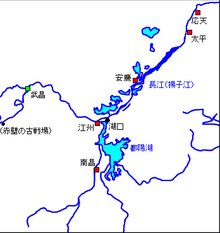Battle of Lake Poyang
| Battle of Lake Poyang | |||||||
|---|---|---|---|---|---|---|---|
| Part of Red Turban Rebellion | |||||||
| |||||||
| Belligerents | |||||||
| Han navy | Ming navy | ||||||
| Commanders and leaders | |||||||
| Chen Youliang † | Zhu Yuanzhang | ||||||
| Strength | |||||||
|
Over 100 vesselsb 650,000 men | 200,000 men | ||||||
| Casualties and losses | |||||||
| Chen Youliang and most of his army |
1,346 dead 11,347 wounded | ||||||
|
a Wakeman (1993), p. 8, n. 37. b TTSL, 13/165, quoted in Hok-lam Chan (1975), p. 703. | |||||||
The battle of Lake Poyang (鄱陽湖之戰) was a naval conflict which took place 30 August – 4 October 1363 between the rebel forces of Zhu Yuanzhang and Chen Youliang during the Red Turban Rebellion which led to the fall of the Yuan dynasty. Chen Youliang besieged Nanchang with a large fleet on Lake Poyang, China's largest freshwater lake, and Zhu Yuanzhang met his force with a smaller fleet. After an inconclusive engagement exchanging fire, Zhu employed fire ships to burn the enemy tower ships and destroyed their fleet. This was the last major battle of the rebellion prior to the rise of the Ming dynasty.
Background
On 30 August, the forces of Chen Han conducted a major amphibious assault on Nanchang with a hundred vessels and several hundred troops. The town of Nanchang was strategically located to guard Lake Poyang, which connected the Yangtze with other river basins. During the early 1360s Zhu Yuanzhang held key garrisons on the lake and administered them from Nanjing 560 kilometers downriver. Chen Youliang tried to deposit his troops on the city walls with "tower ships". This proved futile as the city defenders simply moved the walls back and Chen was forced to personally lead an assault on the city gates. They were repelled with a barrage of cannonfire and driven back. After this failure, Chen set up a blockade, determined to starve out the defenders, but a small fishing boat managed to slip out and reached Nanjing in time to warn Zhu Yuanzhang.[1]
The battle

Zhu Yuanzhang's fleet arrived at Poyang Lake on 29 August with a force only a third the size of Chen's army. According to one Ming source, Zhu's forces arrived armed with "fire bombs, fire guns, fire arrows, fire seeds [probably grenades], large and small fire lances, large and small 'commander' fire-tubes, large and small iron bombs, rockets."[2] This shows that older gunpowder weapons co-existed alongside guns, and proto-guns such as fire lances were not supplanted until after early Ming. A new weapon called the "No Alternative" was also mentioned. The No Alternative was "made from a circular reed mat about five inches around and seven feet long that was pasted over with red paper and bound together with silk and hemp— stuffed inside it was gunpowder twisted in with bullets and all kinds of [subsidiary] gunpowder weapons."[2] It was hung from a pole on the foremast, and when an enemy ship came into close range, the fuse was lit, and the weapon would supposedly fall onto the enemy ship, at which point things inside shot out "and burned everything to bits, with no hope of salvation."[2]
On 30 August, Zhu's fleet engaged Chen's under orders to "get close to the enemy's ships and first set off gunpowder weapons (發火器), then bows and crossbows, and finally attack their ships with short range weapons."[3] Fire bombs were hurled using naval trebuchets and the Ming succeeded in "burning twenty or more enemy vessels and killing or drowning many enemy troops," but their own flagship also caught fire and hit a sandbar, forcing them to withdraw.[4]
On 31 August, the Ming rammed the enemy fleet with fire ships. While guns were used during the battle, ultimately they were not pivotal to success, and the battle was won using incendiary weapons.[5]
On 2 September, the two fleets engaged in battle again, but the tide turned on Chen's forces, and they were forced to withdraw. Afterwards, Zhu's fleet settled into a blockade for another month until they employed fire ships again on 4 October, destroying the rest of Chen's fleet. Chen Youliang was killed when an arrow struck his head.
Aftermath
Chen Youliang was succeeded by his son, Chen Li, who surrendered to Zhu in 1364.
The Ming victory here cemented their position as the leading rebel group, and the one that would take command when the Yuan Dynasty fell. When this happened five years later, Zhu Yuanzhang became the first Emperor of the Ming Dynasty as Hongwu.
See also
References
- ↑ Andrade 2016, p. 59.
- 1 2 3 Andrade 2016, p. 60.
- ↑ Andrade 2016, p. 61.
- ↑ Andrade 2016, p. 62.
- ↑ Andrade 2016, p. 63.
Further reading
- Andrade, Tonio (2016), The Gunpowder Age: China, Military Innovation, and the Rise of the West in World History, Princeton University Press, ISBN 978-0-691-13597-7 .
- Hok-lam Chan, 'The Rise of Ming T'ai-tsu (1368–98): Facts and Fictions in Early Ming Official Historiography', Journal of the American Oriental Society, Vol. 95, No. 4 (Oct. - Dec., 1975), p. 703, quoting TTSL, 13/165, abbreviation for (Ming) T'ai-tsu shih-lu (1418), ed. Yao Kuang-hsiao (1335-1418) et al., 257 chüan. Academia Sinica, Taipei 1962. (1.1.1.).
- Dreyer, Edward L., 'The Poyang Campaign of 1363: Inland Naval Warfare in the Founding of the Ming Dynasty,' in Kierman, Frank A., and Fairbank, John K. (eds.), Chinese Ways in Warfare (Cambridge, MA., Harvard University Press, 1974).
- Turnbull, Stephen, 'Fighting Ships of the Far East (1): China and Southeast Asia 202 BC - AD 1419.' (Oxford: Osprey Publishing, 2002).
- Wakeman, Frederic, Jr., 'Voyages', American Historical Review, Vol. 98, No. 1 (Feb., 1993), pp. 1–17.